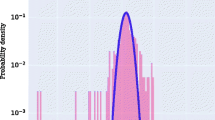Abstract
We extend an aggregative growth model for a small open economy by developing a framework in which boundedly rational agents raise credit in proportion to their expected income. Moreover, these agents are heterogeneous in the sense that they switch between an extrapolative and a regressive forecasting rule with respect to perceived market circumstances. Using a mixture of analytical and numerical tools, we attempt to describe the characteristics of our model’s dynamical system. Our results then suggest that self-fulfilling short-run expectations do not only have important consequences for fluctuations in economic activity but are also a source of simple endogenous dynamics.




Similar content being viewed by others
Notes
Please note the time structure of our model. All decisions regarding credit and savings are made at the beginning of each period, while income is generated afterwards. Thus, credit decisions have to rely on expectations of the income which will be earned in the current period. Unfortunately, these expectations are hard to observe such that the empirical evidence of the proposed relationship is rare at best. For example, Bacchetta and Gerlach (1997) find a high positive correlation between consumption and credit growth, indicating that credit may adjust to (desired) consumption which, in turn, relates to expected (future) income. Alternatively and favoured by the authors, credit constraints may also be reflected in consumption.
It is worth noting that there exists no consensus on how to incorporate heterogeneous beliefs in a macroeconomic framework. However, Anufriev et al. (2008) argue that the most natural way to embed heterogeneous expectations in a linear macroeconomic framework which has no underlying microfoundation is to use a simple weighted average of the individual expectations.
Of course, \(\overline{y}=0\) also defines a steady-state solution of our nonlinear system. But since this trivial solution is not particularly meaningful from an economic point of view, we will omit it in the further discussion.
Clearly, these results may change if we allow the risk-free interest rate to become unrealistically high and to exceed \(r>1\). In this case, condition (24) may also be violated for certain parameter combinations. However, since this theoretical case is too detached from reality we will omit it in the further examination.
More precisely, (25) is not a necessary and sufficient condition for a Neimark–Sacker bifurcation to occur, that is, violation of (25) just implies a loss of stability but does not necessarily imply the birth of a Neimark–Sacker bifurcation, the existence of which still has to be proven. However, the exact mathematical proof is tricky at best and may not be accomplished easily. For that reason, a majority in the economic literature tends to accept condition (25) as being both necessary and sufficient if the existence of the predicted bifurcation is numerically confirmed.
That is to say, \(\sigma =0\) indicates that the system is in equilibrium.
References
Anufriev, M., Assenza, T., Hommes, C., Massaro, D.: Interest Rate Rules With Heterogeneous Expectations, CeNDEF Working Paper, 08–08, University of Amsterdam (2008)
Bacchetta, P., Gerlach, S.: Consumption and credit constraints: international evidence. J. Monet. Econ. 40, 207–238 (1997)
Branch, W.A.: The theory of rationally heterogeneous expectations: evidence form survey data on inflation expectations. Econ. J. 114(497), 592–621 (2004)
Brock, W.A., Mirman, L.J.: Optimal economic growth and uncertainty: the discounted case. J. Econ. Theory 4, 479–513 (1972)
Caselli, F., Ventura, J.: A representative consumer theory of distribution. Am. Econ. Rev. 90, 909–926 (2000)
Cass, D.: Optimum growth in an aggregative model of capital accumulation. Rev. Econ. Stud. 32, 233–240 (1965)
Cooper, G.: The Origin of Financial Crises. Harriman House, London (2008)
Domar, E.D.: Capital expansion, rate of growth, and employment. Econometrica 14, 137–147 (1946)
Gandolfo, G.: Economic Dynamics, 4th edn. Springer, Berlin (2009)
Gomes, O.: Deterministic randomness in a model of finance and growth. J. Evolut. Econ. 20, 96–114 (2010)
Harrod, R.F.: An essay in dynamic theory. Econ. J. 49, 14–33 (1939)
Heemeijer, P., Hommes, C., Sonnemans, J., Tuinstra, J.: Price stability and volatility in markets with positive and negative expectations feedback: an experimental investigation. J. Econ. Dyn. Control 33(05), 1052–1072 (2009)
Hommes, C., Sonnemans, J., Tuinstra, J., van de Velden, H.: Coordination of expectations in asset pricing experiments. Rev. Financ. Stud. 18(03), 955–980 (2005)
Japelli, T.: Who is credit constrained in the US economy? Q. J. Econ. 105, 219–234 (1990)
Koopmans, T.C.: On the Concept of Optimal Economic Growth. Yale University, Cowles Foundation Discussion Papers (1963)
Lines, M.: Bifurcation scenarios in a heterogeneous agent, multiplier-accelerator model. Pure Math. Appl. 16, 429–442 (2007a)
Lines, M.: Practical Tools for Identifying Dynamics in Discrete Systems. Department of Statistics, University of Udine, Working Paper (2007b)
Lines, M., Westerhoff, F.: Expectations and the multiplier-accelerator model. In: Business Cycle Dynamics: Models and Tools, Springer, Berlin, pp. 255–276 (2006)
Romer, P.M.: Increasing returns and long-run growth. J. Polit. Econ. 94, 1002–1037 (1986)
Simon, H.A.: A behavioral model of rational choice. Q. J. Econ. 69, 99–118 (1955)
Smith, V.L., Suchanek, G.L., Williams, A.W.: Bubbles, crashes, and endogenous expectations in experimental spot asset markets. Econometrica 56, 1119–1151 (1988)
Solow, R.M.: A contribution to the theory of economic growth. Q. J. Econ. 70, 65–94 (1956)
Stiglitz, J.E.: Distribution of income and wealth among individuals. Econometrica 37, 382–397 (1969)
Swan, T.W.: Economic growth and capital accumulation. Econ. Rec. 32, 334–361 (1956)
Tversky, A., Kahneman, D.: Judgment under uncertainty: heuristics and biases. Science 185, 1124–1131 (1974)
Wegener, M., Westerhoff, F., Zaklan, G.: A metzlerian business cycle model with nonlinear heterogeneous expectations. Econ. Model. 26, 715–720 (2009)
Westerhoff, F.H.: Samuelson’s multiplier-accelerator model revisited. Appl. Econ. Lett. 13, 89–92 (2006)
Author information
Authors and Affiliations
Corresponding author
Rights and permissions
About this article
Cite this article
Wegener, M. Heterogeneous expectations and debt in a growth model for a small open economy. Decisions Econ Finan 37, 125–136 (2014). https://doi.org/10.1007/s10203-013-0142-1
Received:
Accepted:
Published:
Issue Date:
DOI: https://doi.org/10.1007/s10203-013-0142-1




